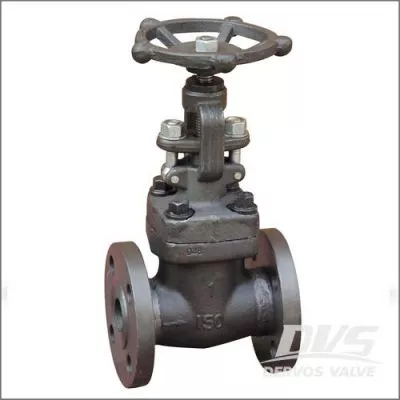Method for preventing forged steel valves from cavitation erosion
1) Forged steel valve structure
Although the structure of the forged steel valve is independent of the flash evaporation generation, it can suppress the destruction of the flashing. An angular valve structure that uses a medium to flow from top to bottom is more resistant to flash evaporation damage than a spherical valve body. Flash evaporation destruction is caused by high velocity saturated bubbles impinging on the surface of the valve body and corroding the surface of the valve body. Since the medium in the angle valve flows directly to the center of the downstream pipe inside the valve body, and does not directly impact the body wall like a spherical valve, the destructive force of the flash evaporation is greatly reduced.
2) Material selection
In general, high hardness materials are more resistant to flash evaporation and cavitation damage. High hardness materials are generally used to make valve bodies. For example, the forged chrome-molybdenum alloy steel valve is often used in the power industry. WC9 is one of the commonly used corrosion-resistant materials. If the pipe with a high hardness is installed downstream of the angle valve, the valve body can be made of carbon steel because the flash vaporized liquid is only present in the downstream part of the valve body.
3) Tortuous path
Making the flow medium passing through a throttling component containing a tortuous path is one way to reduce pressure recovery. Although such a tortuous path can have different forms, such as small holes, radial flow paths, and the like, the effect of each design is basically the same. This tortuous path can be utilized in a variety of component designs that control the occurrence of cavitation erosion.
4) Multi-stage decompression
Each of the multi-stage decompression consumes a portion of the energy, so that the inlet pressure of the next stage is relatively low, the pressure difference of the next stage is reduced, the pressure recovery is low, and cavitation erosion is avoided. A successful design allows the forged steel valve to maintain a higher pressure than the liquid saturation pressure while withstanding large pressure differentials, and prevent the formation of liquid cavitation erosion. Therefore, for the same pressure drop, the single throttling is more likely to generate cavitation erosion than the multi-stage throttling.
5) Porous throttling design
Porous throttling is a comprehensive design. Using a special seat and disc configuration, the pressure of each point of high-speed liquid passing through the seat and the flap is higher than the saturated vapor pressure at that temperature. The convergence jet method is adopted to convert the kinetic energy of the liquid in the regulating valve into heat energy due to mutual friction, thereby reducing the formation of bubbles. On the other hand, the rupture of the bubble occurs in the center of the sleeve, avoiding direct damage to the valve seat and the flap surface.
